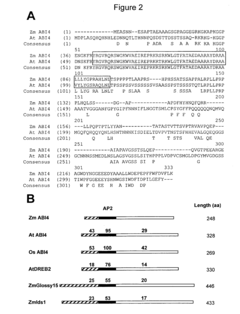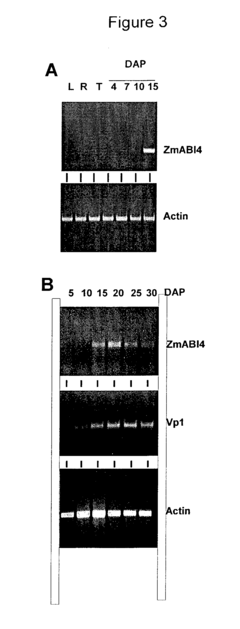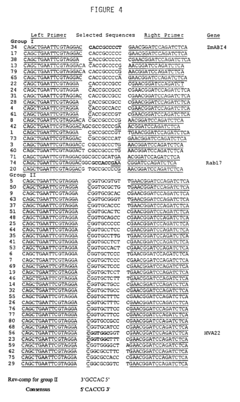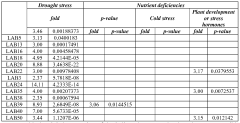How Abscisic Acid Coordinates Plant Stress Acclimatization?
JUL 14, 20259 MIN READ
Generate Your Research Report Instantly with AI Agent
Patsnap Eureka helps you evaluate technical feasibility & market potential.
ABA Signaling Background
Abscisic acid (ABA) is a crucial plant hormone that plays a pivotal role in coordinating plant responses to various environmental stresses. The ABA signaling pathway has been extensively studied over the past decades, revealing a complex network of molecular interactions that enable plants to adapt to adverse conditions.
ABA was first discovered in the 1960s as a growth inhibitor and dormancy promoter. Since then, its significance in plant stress responses has become increasingly apparent. The hormone is synthesized in response to abiotic stresses such as drought, salinity, and extreme temperatures. Upon perception of these stresses, ABA biosynthesis is rapidly upregulated, primarily through the activation of 9-cis-epoxycarotenoid dioxygenase (NCED) enzymes.
The core ABA signaling pathway involves three main components: ABA receptors, protein phosphatases, and transcription factors. The PYR/PYL/RCAR family of proteins serves as ABA receptors, which undergo conformational changes upon binding to ABA. This conformational shift allows the receptors to interact with and inhibit type 2C protein phosphatases (PP2Cs), such as ABI1 and ABI2.
PP2Cs are negative regulators of ABA signaling, and their inhibition by the ABA-receptor complex leads to the activation of SNF1-related protein kinase 2 (SnRK2) proteins. SnRK2s are key positive regulators of ABA signaling, phosphorylating various downstream targets, including transcription factors and ion channels.
One of the primary targets of SnRK2s is the AREB/ABF family of transcription factors. These bZIP transcription factors bind to ABA-responsive elements (ABREs) in the promoter regions of ABA-responsive genes, inducing their expression. This transcriptional reprogramming is essential for the plant's adaptation to stress conditions.
The ABA signaling pathway also interacts with other hormonal pathways and signaling networks, creating a complex web of responses that fine-tune the plant's physiological and developmental processes. For instance, ABA antagonizes the effects of growth-promoting hormones like gibberellins and cytokinins, thereby redirecting resources from growth to stress tolerance.
Recent advances in molecular biology and genetics have greatly expanded our understanding of ABA signaling. The identification of ABA receptors and the elucidation of the core signaling module have provided a mechanistic framework for understanding how plants perceive and respond to stress signals. This knowledge has opened up new avenues for improving crop stress tolerance through genetic engineering and breeding strategies.
ABA was first discovered in the 1960s as a growth inhibitor and dormancy promoter. Since then, its significance in plant stress responses has become increasingly apparent. The hormone is synthesized in response to abiotic stresses such as drought, salinity, and extreme temperatures. Upon perception of these stresses, ABA biosynthesis is rapidly upregulated, primarily through the activation of 9-cis-epoxycarotenoid dioxygenase (NCED) enzymes.
The core ABA signaling pathway involves three main components: ABA receptors, protein phosphatases, and transcription factors. The PYR/PYL/RCAR family of proteins serves as ABA receptors, which undergo conformational changes upon binding to ABA. This conformational shift allows the receptors to interact with and inhibit type 2C protein phosphatases (PP2Cs), such as ABI1 and ABI2.
PP2Cs are negative regulators of ABA signaling, and their inhibition by the ABA-receptor complex leads to the activation of SNF1-related protein kinase 2 (SnRK2) proteins. SnRK2s are key positive regulators of ABA signaling, phosphorylating various downstream targets, including transcription factors and ion channels.
One of the primary targets of SnRK2s is the AREB/ABF family of transcription factors. These bZIP transcription factors bind to ABA-responsive elements (ABREs) in the promoter regions of ABA-responsive genes, inducing their expression. This transcriptional reprogramming is essential for the plant's adaptation to stress conditions.
The ABA signaling pathway also interacts with other hormonal pathways and signaling networks, creating a complex web of responses that fine-tune the plant's physiological and developmental processes. For instance, ABA antagonizes the effects of growth-promoting hormones like gibberellins and cytokinins, thereby redirecting resources from growth to stress tolerance.
Recent advances in molecular biology and genetics have greatly expanded our understanding of ABA signaling. The identification of ABA receptors and the elucidation of the core signaling module have provided a mechanistic framework for understanding how plants perceive and respond to stress signals. This knowledge has opened up new avenues for improving crop stress tolerance through genetic engineering and breeding strategies.
Plant Stress Response Needs
Plants face numerous environmental stresses throughout their lifecycle, including drought, extreme temperatures, salinity, and pathogen attacks. These stressors can significantly impact plant growth, development, and productivity, leading to substantial agricultural losses worldwide. As global climate change intensifies, the frequency and severity of these stress events are expected to increase, further threatening food security and ecosystem stability.
To cope with these challenges, plants have evolved sophisticated stress response mechanisms. These mechanisms involve complex signaling networks that detect environmental cues, transduce signals, and activate appropriate physiological and biochemical responses. Understanding and enhancing these stress response pathways is crucial for developing more resilient crops and sustainable agricultural practices.
One of the primary needs in plant stress response research is the development of crops with improved stress tolerance. This requires a comprehensive understanding of the molecular mechanisms underlying stress perception, signal transduction, and adaptive responses. Researchers are focusing on identifying key genes, proteins, and metabolites involved in stress tolerance, as well as elucidating the regulatory networks that coordinate these responses.
Another critical need is the development of rapid and efficient screening methods for stress-tolerant plant varieties. Traditional breeding approaches are time-consuming and labor-intensive, making it challenging to keep pace with changing environmental conditions. High-throughput phenotyping technologies and advanced genomic tools are being employed to accelerate the identification and selection of stress-resistant traits.
Furthermore, there is a growing need for integrative approaches that consider multiple stress factors simultaneously. In natural environments, plants often face a combination of stresses, and their responses to these complex scenarios may differ from their reactions to individual stressors. Research efforts are focusing on understanding the crosstalk between different stress response pathways and developing strategies to enhance plant resilience against multiple stresses.
The role of plant hormones in stress responses is another area of intense research. Hormones such as abscisic acid (ABA), jasmonic acid, and salicylic acid play crucial roles in coordinating plant responses to various environmental challenges. Unraveling the intricate hormonal signaling networks and their interactions with other cellular processes is essential for developing targeted approaches to enhance stress tolerance.
Lastly, there is a pressing need for translating laboratory findings into practical applications in the field. This involves developing innovative agronomic practices, breeding strategies, and biotechnological interventions that can effectively improve plant stress tolerance under real-world conditions. Collaboration between plant biologists, agronomists, and biotechnologists is crucial to bridge the gap between fundamental research and practical solutions for sustainable agriculture.
To cope with these challenges, plants have evolved sophisticated stress response mechanisms. These mechanisms involve complex signaling networks that detect environmental cues, transduce signals, and activate appropriate physiological and biochemical responses. Understanding and enhancing these stress response pathways is crucial for developing more resilient crops and sustainable agricultural practices.
One of the primary needs in plant stress response research is the development of crops with improved stress tolerance. This requires a comprehensive understanding of the molecular mechanisms underlying stress perception, signal transduction, and adaptive responses. Researchers are focusing on identifying key genes, proteins, and metabolites involved in stress tolerance, as well as elucidating the regulatory networks that coordinate these responses.
Another critical need is the development of rapid and efficient screening methods for stress-tolerant plant varieties. Traditional breeding approaches are time-consuming and labor-intensive, making it challenging to keep pace with changing environmental conditions. High-throughput phenotyping technologies and advanced genomic tools are being employed to accelerate the identification and selection of stress-resistant traits.
Furthermore, there is a growing need for integrative approaches that consider multiple stress factors simultaneously. In natural environments, plants often face a combination of stresses, and their responses to these complex scenarios may differ from their reactions to individual stressors. Research efforts are focusing on understanding the crosstalk between different stress response pathways and developing strategies to enhance plant resilience against multiple stresses.
The role of plant hormones in stress responses is another area of intense research. Hormones such as abscisic acid (ABA), jasmonic acid, and salicylic acid play crucial roles in coordinating plant responses to various environmental challenges. Unraveling the intricate hormonal signaling networks and their interactions with other cellular processes is essential for developing targeted approaches to enhance stress tolerance.
Lastly, there is a pressing need for translating laboratory findings into practical applications in the field. This involves developing innovative agronomic practices, breeding strategies, and biotechnological interventions that can effectively improve plant stress tolerance under real-world conditions. Collaboration between plant biologists, agronomists, and biotechnologists is crucial to bridge the gap between fundamental research and practical solutions for sustainable agriculture.
ABA Perception Mechanisms
Abscisic acid (ABA) perception mechanisms play a crucial role in coordinating plant stress acclimatization. The primary ABA receptors in plants are the PYR/PYL/RCAR protein family, which form the core of the ABA signaling pathway. These receptors undergo conformational changes upon binding to ABA, enabling them to interact with and inhibit protein phosphatases of the PP2C family.
The PYR/PYL/RCAR receptors are soluble proteins that can be found in both the cytosol and nucleus. They possess a conserved START domain, which forms a ligand-binding pocket capable of accommodating ABA molecules. When ABA binds to this pocket, it induces a structural shift in the receptor, closing a "gate" and "latch" that secures the hormone within the binding site.
This conformational change creates a surface that can interact with PP2C phosphatases, such as ABI1 and ABI2. The binding of PP2Cs to the ABA-receptor complex effectively inhibits their phosphatase activity. This inhibition is a critical step in ABA signaling, as it releases SnRK2 protein kinases from negative regulation by PP2Cs.
The activation of SnRK2 kinases is a pivotal event in the ABA signaling cascade. These kinases phosphorylate various downstream targets, including transcription factors like ABFs (ABA-responsive element binding factors), ion channels, and other regulatory proteins. This phosphorylation cascade leads to the activation of ABA-responsive genes and the modulation of cellular processes that contribute to stress tolerance.
In addition to the PYR/PYL/RCAR receptors, other proteins have been implicated in ABA perception. For instance, the G-protein coupled receptor (GPCR) GTG1/GTG2 has been proposed as a plasma membrane-localized ABA receptor. However, its role in ABA signaling is less well-established compared to the PYR/PYL/RCAR family.
Recent research has also revealed the importance of ABA transport mechanisms in fine-tuning ABA responses. The ABCG class of transporters, particularly ABCG40, has been shown to facilitate ABA uptake into cells, thereby influencing the local concentration of ABA available for receptor binding.
The complexity of ABA perception is further enhanced by the existence of multiple PYR/PYL/RCAR family members in plants, each with potentially different affinities for ABA and PP2Cs. This diversity allows for a nuanced response to varying ABA concentrations and different stress conditions, enabling plants to fine-tune their stress responses.
Understanding these intricate ABA perception mechanisms is crucial for developing strategies to enhance plant stress tolerance. By manipulating receptor sensitivity or abundance, it may be possible to engineer crops with improved drought resistance or other stress-tolerant traits, contributing to sustainable agriculture in the face of climate change.
The PYR/PYL/RCAR receptors are soluble proteins that can be found in both the cytosol and nucleus. They possess a conserved START domain, which forms a ligand-binding pocket capable of accommodating ABA molecules. When ABA binds to this pocket, it induces a structural shift in the receptor, closing a "gate" and "latch" that secures the hormone within the binding site.
This conformational change creates a surface that can interact with PP2C phosphatases, such as ABI1 and ABI2. The binding of PP2Cs to the ABA-receptor complex effectively inhibits their phosphatase activity. This inhibition is a critical step in ABA signaling, as it releases SnRK2 protein kinases from negative regulation by PP2Cs.
The activation of SnRK2 kinases is a pivotal event in the ABA signaling cascade. These kinases phosphorylate various downstream targets, including transcription factors like ABFs (ABA-responsive element binding factors), ion channels, and other regulatory proteins. This phosphorylation cascade leads to the activation of ABA-responsive genes and the modulation of cellular processes that contribute to stress tolerance.
In addition to the PYR/PYL/RCAR receptors, other proteins have been implicated in ABA perception. For instance, the G-protein coupled receptor (GPCR) GTG1/GTG2 has been proposed as a plasma membrane-localized ABA receptor. However, its role in ABA signaling is less well-established compared to the PYR/PYL/RCAR family.
Recent research has also revealed the importance of ABA transport mechanisms in fine-tuning ABA responses. The ABCG class of transporters, particularly ABCG40, has been shown to facilitate ABA uptake into cells, thereby influencing the local concentration of ABA available for receptor binding.
The complexity of ABA perception is further enhanced by the existence of multiple PYR/PYL/RCAR family members in plants, each with potentially different affinities for ABA and PP2Cs. This diversity allows for a nuanced response to varying ABA concentrations and different stress conditions, enabling plants to fine-tune their stress responses.
Understanding these intricate ABA perception mechanisms is crucial for developing strategies to enhance plant stress tolerance. By manipulating receptor sensitivity or abundance, it may be possible to engineer crops with improved drought resistance or other stress-tolerant traits, contributing to sustainable agriculture in the face of climate change.
ABA-Mediated Responses
01 Genetic modification for ABA-mediated stress tolerance
Genetic engineering techniques are used to enhance plant tolerance to environmental stresses by modifying genes involved in abscisic acid (ABA) signaling pathways. This approach can improve plant resistance to various abiotic stresses such as drought, salinity, and extreme temperatures.- Abscisic acid signaling pathways in stress response: Abscisic acid (ABA) plays a crucial role in plant stress response through various signaling pathways. These pathways involve receptors, kinases, and transcription factors that regulate gene expression and physiological responses to environmental stresses such as drought, salinity, and temperature extremes. Understanding these signaling mechanisms is essential for developing strategies to enhance plant stress tolerance.
- Genetic modification for improved stress tolerance: Genetic engineering techniques are used to modify plants for enhanced stress tolerance through the manipulation of ABA-related genes. This includes overexpression of genes involved in ABA biosynthesis, signaling, or response, as well as the introduction of novel genes that can improve plant performance under stress conditions. These modifications aim to develop crops with increased resilience to environmental challenges.
- ABA-mediated stomatal regulation: ABA plays a critical role in regulating stomatal closure, which is a key mechanism for plants to conserve water during drought stress. Research focuses on understanding the molecular mechanisms of ABA-induced stomatal closure and developing methods to enhance this response for improved drought tolerance in plants.
- ABA-induced gene expression and protein synthesis: ABA triggers the expression of stress-responsive genes and the synthesis of proteins that contribute to stress acclimatization. These include dehydrins, late embryogenesis abundant (LEA) proteins, and enzymes involved in osmolyte production. Understanding and manipulating these processes can lead to improved stress tolerance in plants.
- ABA-based agricultural applications: Development of ABA-based agricultural products and techniques for enhancing crop stress tolerance. This includes the use of ABA analogs, ABA-priming treatments, and the application of compounds that modulate ABA signaling or biosynthesis. These approaches aim to improve crop performance under various environmental stresses in field conditions.
02 ABA-responsive promoter elements
Identification and utilization of ABA-responsive promoter elements to regulate gene expression in response to stress conditions. These elements can be used to develop stress-tolerant crops by controlling the expression of genes involved in stress response pathways.Expand Specific Solutions03 Exogenous application of ABA for stress acclimatization
Application of exogenous ABA or ABA analogs to plants to enhance their stress tolerance. This method can be used to improve plant performance under various environmental stresses, including drought, salinity, and temperature extremes.Expand Specific Solutions04 ABA-mediated stomatal regulation
Manipulation of ABA-induced stomatal closure to improve water use efficiency and drought tolerance in plants. This approach focuses on enhancing the plant's ability to conserve water during periods of water scarcity.Expand Specific Solutions05 ABA signaling cross-talk with other stress pathways
Investigation of the interactions between ABA signaling and other stress response pathways, such as those involving reactive oxygen species or other plant hormones. Understanding these interactions can lead to the development of more comprehensive stress acclimatization strategies.Expand Specific Solutions
Key ABA Research Groups
The research on abscisic acid's role in plant stress acclimatization is in a mature stage, with significant market potential due to its applications in agriculture and biotechnology. The global market for plant stress tolerance is projected to grow substantially, driven by climate change concerns and food security needs. Technologically, major players like The Regents of the University of California, Evogene Ltd., and Valent BioSciences Corp. have made significant advancements in understanding and manipulating abscisic acid pathways. Academic institutions such as China Agricultural University and the Technical University of Denmark are also contributing to the field's progress. Companies like BASF Corp. and Syngenta Participations AG are leveraging this research to develop stress-resistant crop varieties and agricultural products.
The Regents of the University of California
Technical Solution: The University of California has made significant contributions to understanding how Abscisic Acid (ABA) coordinates plant stress acclimatization. Their research focuses on the molecular mechanisms of ABA signaling and its role in drought stress response. They have identified key components of the ABA signaling pathway, including the PYR/PYL/RCAR receptors, PP2C phosphatases, and SnRK2 kinases [1]. Their studies have shown that ABA triggers rapid responses to water deficit by activating ion channels and slow adaptive responses by inducing gene expression [2]. They have also elucidated the role of ABA in stomatal closure, a crucial mechanism for water conservation during drought stress [3]. Recent work has explored the crosstalk between ABA and other hormones in stress response coordination [4].
Strengths: Comprehensive understanding of ABA signaling pathways; Identification of key molecular players in ABA-mediated stress response; Long-standing expertise in plant molecular biology. Weaknesses: Focus primarily on model plants may limit direct agricultural applications; Potential gaps in understanding ABA's role in field conditions.
China Agricultural University
Technical Solution: China Agricultural University has made substantial progress in elucidating the role of Abscisic Acid (ABA) in plant stress acclimatization, with a particular focus on crop plants. Their research has revealed novel ABA receptors and signaling components specific to important crops like rice and wheat [5]. They have developed transgenic crop lines with enhanced ABA sensitivity, demonstrating improved drought tolerance and water use efficiency in field trials [6]. Their studies have also uncovered the intricate interplay between ABA and other phytohormones in coordinating responses to multiple stresses, such as drought and salinity [7]. Recent work has focused on the epigenetic regulation of ABA-responsive genes, providing insights into long-term stress adaptation mechanisms in plants [8].
Strengths: Strong focus on agriculturally relevant crops; Integration of molecular insights with field-level applications; Expertise in genetic engineering for stress tolerance. Weaknesses: May have less emphasis on basic ABA signaling mechanisms compared to some other institutions; Potential regulatory challenges in implementing genetically modified crops.
Core ABA Signaling Pathways
Genes and regulatory DNA sequences associated with stress-related gene expression in plants and methods of using the same
PatentInactiveUS7176027B2
Innovation
- The use of the maize ZmABI4 gene and its native promoter to modulate transcription and expression of stress-responsive genes, allowing for controlled and targeted activation of stress responses in plants, including the use of stress-inducible and developmentally controlled promoters to optimize gene expression.
Polynucleotides, polypeptides encoded thereby, and methods of using same for increasing abiotic stress tolerance, biomass and/or yield in plants expressing same
PatentWO2010076756A2
Innovation
- Expression of specific exogenous polynucleotides and polypeptides within plants, identified through bioinformatics tools, to increase abiotic stress tolerance, yield, biomass, growth rate, vigor, oil content, fiber quality, and nitrogen use efficiency, using nucleic acid constructs and promoters for directed transcription.
ABA Crosstalk with Hormones
Abscisic acid (ABA) plays a crucial role in plant stress responses, and its interaction with other plant hormones is essential for coordinating plant acclimatization to various environmental stresses. The crosstalk between ABA and other hormones forms a complex network that fine-tunes plant responses to multiple stimuli.
ABA interacts extensively with auxins, cytokinins, and ethylene to regulate plant growth and development under stress conditions. For instance, ABA and auxins work antagonistically in root growth regulation. While ABA inhibits root growth during water stress, auxins promote root elongation. This interplay allows plants to modulate their root architecture in response to changing soil moisture conditions.
The interaction between ABA and cytokinins is particularly important in regulating stomatal closure and leaf senescence. ABA promotes stomatal closure and accelerates leaf senescence under drought stress, while cytokinins generally antagonize these effects. This hormonal balance helps plants optimize water use efficiency and resource allocation during periods of water scarcity.
Ethylene and ABA exhibit both synergistic and antagonistic interactions depending on the specific stress and plant tissue. In seed dormancy and germination, ABA and ethylene act antagonistically, with ABA promoting dormancy and ethylene stimulating germination. However, in some stress responses, such as salt stress, ABA and ethylene can work synergistically to enhance plant tolerance.
The crosstalk between ABA and jasmonates (JAs) is crucial for integrating biotic and abiotic stress responses. While ABA primarily mediates abiotic stress responses, JAs are key players in plant defense against pathogens and herbivores. The interaction between these hormones allows plants to prioritize and balance their responses to multiple concurrent stresses.
Gibberellins (GAs) and ABA also exhibit an antagonistic relationship in various developmental processes. For example, in seed germination, ABA maintains dormancy while GAs promote germination. This hormonal balance is critical for ensuring that seeds germinate under favorable environmental conditions.
The complex interplay between ABA and other hormones is mediated by various molecular mechanisms, including shared signaling components, transcription factors, and regulatory proteins. Understanding these intricate interactions is crucial for developing strategies to enhance crop resilience to multiple stresses in changing climatic conditions.
ABA interacts extensively with auxins, cytokinins, and ethylene to regulate plant growth and development under stress conditions. For instance, ABA and auxins work antagonistically in root growth regulation. While ABA inhibits root growth during water stress, auxins promote root elongation. This interplay allows plants to modulate their root architecture in response to changing soil moisture conditions.
The interaction between ABA and cytokinins is particularly important in regulating stomatal closure and leaf senescence. ABA promotes stomatal closure and accelerates leaf senescence under drought stress, while cytokinins generally antagonize these effects. This hormonal balance helps plants optimize water use efficiency and resource allocation during periods of water scarcity.
Ethylene and ABA exhibit both synergistic and antagonistic interactions depending on the specific stress and plant tissue. In seed dormancy and germination, ABA and ethylene act antagonistically, with ABA promoting dormancy and ethylene stimulating germination. However, in some stress responses, such as salt stress, ABA and ethylene can work synergistically to enhance plant tolerance.
The crosstalk between ABA and jasmonates (JAs) is crucial for integrating biotic and abiotic stress responses. While ABA primarily mediates abiotic stress responses, JAs are key players in plant defense against pathogens and herbivores. The interaction between these hormones allows plants to prioritize and balance their responses to multiple concurrent stresses.
Gibberellins (GAs) and ABA also exhibit an antagonistic relationship in various developmental processes. For example, in seed germination, ABA maintains dormancy while GAs promote germination. This hormonal balance is critical for ensuring that seeds germinate under favorable environmental conditions.
The complex interplay between ABA and other hormones is mediated by various molecular mechanisms, including shared signaling components, transcription factors, and regulatory proteins. Understanding these intricate interactions is crucial for developing strategies to enhance crop resilience to multiple stresses in changing climatic conditions.
ABA Applications in Agriculture
Abscisic acid (ABA) has emerged as a powerful tool in agricultural applications, offering significant potential for enhancing crop resilience and productivity. The hormone's ability to coordinate plant stress responses makes it particularly valuable in addressing the challenges posed by climate change and increasing environmental stressors.
One of the primary applications of ABA in agriculture is drought management. By exogenously applying ABA or manipulating endogenous ABA levels, farmers can improve water use efficiency in crops. This approach has shown promising results in various species, including maize, wheat, and rice. ABA treatment can induce stomatal closure, reducing water loss through transpiration and helping plants maintain turgor under water-limited conditions.
ABA also plays a crucial role in seed dormancy and germination control. Agricultural practices have leveraged this property to enhance seed quality and optimize germination timing. By treating seeds with ABA or its analogs, farmers can induce dormancy in crops prone to pre-harvest sprouting, thereby improving grain quality and reducing yield losses. Conversely, ABA inhibitors can be used to break dormancy and promote uniform germination in species with deep seed dormancy.
In fruit production, ABA applications have been explored to improve fruit quality and extend shelf life. ABA treatments can enhance fruit coloration, increase sugar content, and improve overall fruit appearance. This is particularly beneficial in grape production, where ABA application can improve berry color and composition. Additionally, post-harvest ABA treatments have shown potential in delaying fruit ripening and reducing spoilage, extending the marketable period of various fruits.
ABA's role in plant defense responses has also been harnessed in agricultural settings. Exogenous ABA application or genetic manipulation of ABA signaling pathways can enhance plant resistance to various biotic stresses, including pathogen infections and insect herbivory. This approach offers an environmentally friendly alternative to chemical pesticides, aligning with the growing demand for sustainable agricultural practices.
Furthermore, ABA has shown promise in improving crop tolerance to abiotic stresses beyond drought, such as salinity and extreme temperatures. By priming plants with ABA or its analogs, farmers can enhance crop resilience to these environmental challenges, potentially expanding cultivation into marginal lands and mitigating the impacts of climate change on agriculture.
As research in this field progresses, novel ABA-based agricultural technologies are emerging. These include the development of ABA-responsive genetic switches for precise control of gene expression in crops, as well as the design of synthetic ABA analogs with enhanced stability and efficacy. Such innovations hold the potential to revolutionize crop management strategies and contribute to global food security in the face of increasing environmental pressures.
One of the primary applications of ABA in agriculture is drought management. By exogenously applying ABA or manipulating endogenous ABA levels, farmers can improve water use efficiency in crops. This approach has shown promising results in various species, including maize, wheat, and rice. ABA treatment can induce stomatal closure, reducing water loss through transpiration and helping plants maintain turgor under water-limited conditions.
ABA also plays a crucial role in seed dormancy and germination control. Agricultural practices have leveraged this property to enhance seed quality and optimize germination timing. By treating seeds with ABA or its analogs, farmers can induce dormancy in crops prone to pre-harvest sprouting, thereby improving grain quality and reducing yield losses. Conversely, ABA inhibitors can be used to break dormancy and promote uniform germination in species with deep seed dormancy.
In fruit production, ABA applications have been explored to improve fruit quality and extend shelf life. ABA treatments can enhance fruit coloration, increase sugar content, and improve overall fruit appearance. This is particularly beneficial in grape production, where ABA application can improve berry color and composition. Additionally, post-harvest ABA treatments have shown potential in delaying fruit ripening and reducing spoilage, extending the marketable period of various fruits.
ABA's role in plant defense responses has also been harnessed in agricultural settings. Exogenous ABA application or genetic manipulation of ABA signaling pathways can enhance plant resistance to various biotic stresses, including pathogen infections and insect herbivory. This approach offers an environmentally friendly alternative to chemical pesticides, aligning with the growing demand for sustainable agricultural practices.
Furthermore, ABA has shown promise in improving crop tolerance to abiotic stresses beyond drought, such as salinity and extreme temperatures. By priming plants with ABA or its analogs, farmers can enhance crop resilience to these environmental challenges, potentially expanding cultivation into marginal lands and mitigating the impacts of climate change on agriculture.
As research in this field progresses, novel ABA-based agricultural technologies are emerging. These include the development of ABA-responsive genetic switches for precise control of gene expression in crops, as well as the design of synthetic ABA analogs with enhanced stability and efficacy. Such innovations hold the potential to revolutionize crop management strategies and contribute to global food security in the face of increasing environmental pressures.
Unlock deeper insights with Patsnap Eureka Quick Research — get a full tech report to explore trends and direct your research. Try now!
Generate Your Research Report Instantly with AI Agent
Supercharge your innovation with Patsnap Eureka AI Agent Platform!







